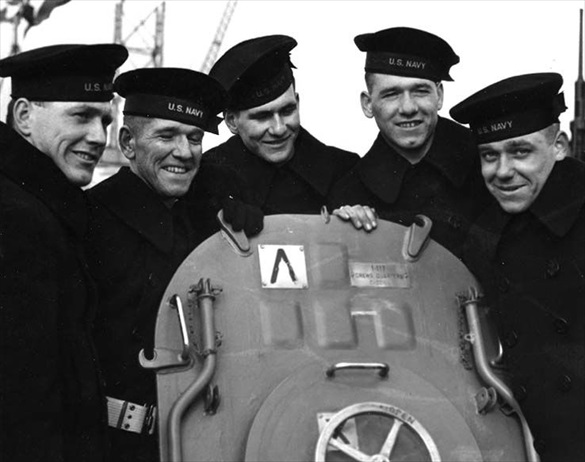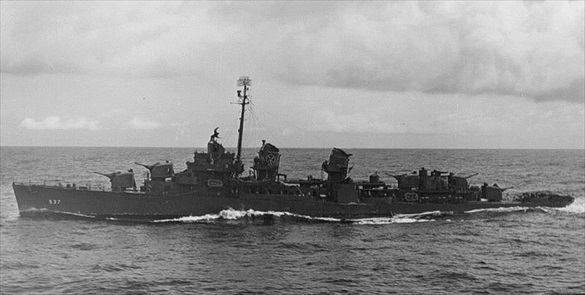FIVE SULLIVAN BROTHERS LOST WITH CRUISER
Department of the Navy, Washington, D.C. · November 13, 1942
Commissioned on February 14, 1942, the light anti-aircraft cruiser USS Juneau (CL-52), named after the capital city of Alaska, first saw service in the Caribbean, where it performed blockade patrol in early May off Martinique and Guadaloupe Islands to prevent the escape of Vichy French Naval units. On August 22, 1942, the cruiser departed for the Pacific Theater assigned with providing protective screening and escort services for, as it happened, the carriers Hornet, Wasp, and Enterprise. On arrival, it was involved in a number of naval engagements during the months-long Guadalcanal Campaign (August 7, 1942 to February 9, 1943), the first major offensive by Allied forces against Japan. On this date in 1942 the Juneau was cut in half by one of three torpedoes fired by Japanese submarine I‑26. Two days earlier the cruiser had been in a fierce battle and had been hit by a Japanese torpedo in the forward fire room. Badly damaged, steaming on one screw at 13 knots, down 12 feet by the bow, the Juneau charted course with other battle-damaged U.S. warships for the Allied rear-area base at Espiritu Santo in the New Hebrides. When torpedoed the second time at or near its ammunition magazines (roughly in the general area where it had been previously hit), the cruiser went down in 20 seconds, taking with her four of five Sullivan brothers in the initial explosion. Despite being wounded, George Sullivan, the fifth brother, made it onto a raft where he survived for several days before succumbing to his wounds and exhaustion or to a shark attack when he left the relative safety of the raft. Of a crew of nearly 700 men, only 10 survived the Juneau’s final mission when plucked from the water eight days later by a PBY Catalina search aircraft. The “Fighting Sullivan Brothers,” as they became known, had enlisted together eleven months earlier, insisting that they serve aboard the same ship. The brothers received Purple Heart Medals posthumously. President Franklin D. Roosevelt sent a letter of condolence to the Sullivan’s parents, and Pope Pius XII sent a rosary along with a message of regret. The Sullivans (DD-537), a U.S. Navy destroyer, was named in honor of the five brothers in April 1943.
[amazon_carousel widget_type=”ASINList” width=”600″ height=”200″ title=”Recommended Reading” market_place=”US” shuffle_products=”False” show_border=”False” asin=”0743245164,0671748742,141968096X,055380670X,0679640231,0786458976,1591145511,0425246299,0803273282,0931209587″ /]
The Five Sullivan Brothers Aboard USS Juneau, February 1942
 |
Above: Sullivan brothers on the USS Juneau, February 14, 1942: Joseph (left), Francis, Albert, Madison, and George. Aged 20 to 27, the Sullivans enlisted in the U.S. Navy on January 3, 1942, with the stipulation that they serve together. The brothers lost their lives when their ship, USS Juneau, was sunk by Japanese submarine I‑26 during the Naval Battle of Guadalcanal on November 13, 1942. This picture of the five brothers was turned into wartime poster with the caption: “They did their part.” As for sub I‑26, just over two years later it disappeared east of Leyte in the Philippines, taking with it the distinction of having sunk more than 51,500 tons, the third highest scoring Japanese submarine in terms of tonnage sunk.
 |
Above: USS The Sullivans (DD-537) off Ponape, Micronesia, May 2, 1944. The loss of the five Sullivan brothers is reputably the greatest military loss by any one American family during World War II. The Sullivans, whose keel was laid down on October 10, 1942, even before the tragedy, was the first ship commissioned in the Navy that honored more than one person. The Fletcher-class destroyer was launched on April 4, 1943, and saw service in the Pacific with Fast Carrier Task Force 58, part of Adm. Raymond Spruance’s Fifth Fleet. The ship, recipient of four battle stars for World War II service and, since 1986, a National Historic Landmark, is berthed in Buffalo, New York, and now serves as a memorial open to the public.
A Tribute to the Five Sullivan Brothers
![]()

 History buffs, there is good news! The Daily Chronicles of World War II is now available as an ebook for $4.99 on Amazon.com. Containing a year’s worth of dated entries from this website, the ebook brings the story of this tumultuous era to life in a compelling, authoritative, and succinct manner. Featuring inventive navigation aids, the ebook enables readers to instantly move forward or backward by month and date to different dated entries. Simple and elegant! Click
History buffs, there is good news! The Daily Chronicles of World War II is now available as an ebook for $4.99 on Amazon.com. Containing a year’s worth of dated entries from this website, the ebook brings the story of this tumultuous era to life in a compelling, authoritative, and succinct manner. Featuring inventive navigation aids, the ebook enables readers to instantly move forward or backward by month and date to different dated entries. Simple and elegant! Click 











